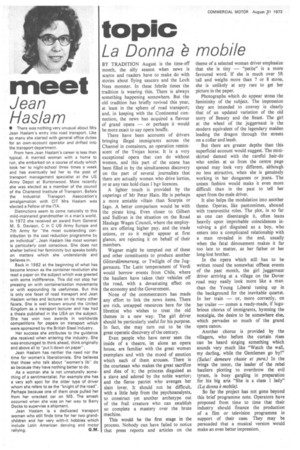topic
Page 54

If you've noticed an error in this article please click here to report it so we can fix it.
La Donna è mobile
BY TRADITION August is the time-off month, the silly season when news is scarce and readers have to make do with stories about flying saucers and the Loch Ness monster. In these febrile times the tradition is wearing thin. There is always something happening somewhere. But the old tradition has briefly revived this year, at least in the sphere of road transport; and, in keeping with the Continental connection, the news has acquired a flavour of grand opera — or perhaps it would be more exact to say opera bouffe.
There have been accounts of drivers bringing illegal immigrants across the Channel in containers, an operation reminiscent of the Trojan horse. It is a very exceptional opera that can do without women, and this part of the scene has been filled in by the simultaneous discovery on the part of several journalists that there are actually women who drive lorries, or at any rate hold class 1 hgv licences.
A lighter touch is provided by the caperings of Mr Peter Hain. He is perhaps a more amiable villain than Scarpia or Iago. A better comparison would be with the pirate king. Even closer to Gilbert and Sullivan is the situation on the Road Haulage Wages Council, where the employers are offering higher pay, and the trade unions, or so it might appear at first glance, are rejecting it on behalf of their members.
Wagner might be tempted out of these and other constituents to produce another Gotterciammerung, or Twilight of the Juggernauts. The Latin temperament of Verdi would borrow events from Chile, where the hauliers have taken their vehicles off the road, with a devastating effect on the economy and the Government.
None of the commentators has made any effort to link the news items. There are rich, untapped resources here for the librettist who wishes to treat the old themes in a new way. The girl driver should be particularly useful for his purpose. In fact, she may turn out to be the great operatic discovery of the century.
Even people who have never seen the inside of a theatre, let alone an opera house, are familiar with the great women exemplars and with the mood of emotion which each of them arouses. There is the courtesan who makes the great sacrifice and dies of it; the princess disguised as a slave and adored by the noble warrior; and the fierce patriot who avenges her slain lover. It should not be difficult, with a little help from the psychoanalysts, to construct yet another archetype out of the frail creature who can establish so complete a mastery over the brute machine.
This would be the first stage in the process. Nobody can have failed to notice that press reports and articles on the theme of a selected woman driver emphasize that she is tiny — "petite" is a more favoured word. If she is much over 5ft tall and weighs more than 7 or 8 stone, she is unlikely at any rate to get her picture in the paper.
Photographs which do appear stress the femininity of the subject. The impression they are intended to convey is clearly that of an updated variation of the old story of Beauty and the Beast. The girl at the wheel of the juggernaut is the modern equivalent of the legendary maiden leading the dragon through the streets on a collar and leash.
But there are greater depths than this superficial account would suggest. The miniskirted damsel with the careful pair-do who smiles at us from the centre page spread may look very different, although no less attractive, when she is genuinely working in her dungarees or jeans. The unisex fashion would make it even more difficult than in the past to tell her apart from the male driver.
It also helps the modulation into another theme. Operas, like pantomimes, abound with transvestite roles. The plot, in so far as one can disentangle it, often leans heavily upon improbable coincidences involving a girl disguised as a boy, who enters into a complicated relationship with a man revealed in the end, usually when the fatal denouement makes it far too late to matter, as her father or her long-lost brother.
In the opera which still has to be written round the somewhat offbeat events of the past month, the girl juggernaut driver arriving at a village on the Dover road may easily look more like a man than the Young Liberal tuning up in the background for the inevitable quartet. In her train — or, more correctly, on her trailer — comes a ready-made, if lugubrious chorus of immigrants, hymning the nostalgia, the desire to be somewhere else, which pervades so much of the grand opera canon.
Another chorus is provided by the villagers, who before the curtain rises can be heard singing something which sounds very much like "Watch the wall, my darling, while the Gentlemen go by!" (Saluti demeure chaste et pure.) In the wings the tenor, the leader of the rebel hauliers plotting to overthrow the evil tyrant, is busy gargling in preparation for his big aria "She is a class 1 lady" (La donna è mobile).
So far the project has not gone beyond this brief programme note. Operators have proposed from time to time that their industry should finance the production of a film or television programme in support of their case. They may be persuaded that a musical version would make an even better impression..












































































































